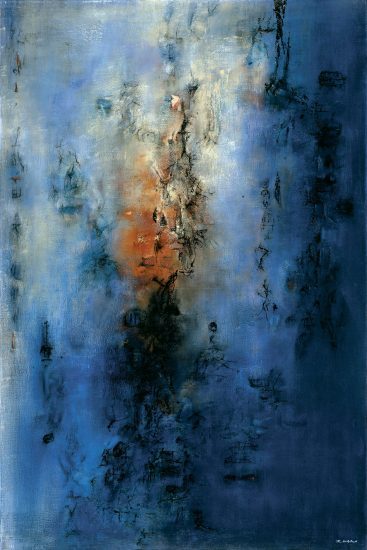
Zao Wou-Ki, “Homage to Chu Yun — 05.05.55,” oil on canvas, 1955 (private collection, Switzerland; photo by Dennis Bouchard)
Asia Society
725 Park Ave. at 70th St.
Daily through January 8, $7-$12 (free Friday nights from 6:00 to 9:00)
212-288-6400
asiasociety.org
“I like people to be able to stroll in my works, as I do when creating them,” Chinese-French painter Zao Wou-Ki said in 1967. Visitors can continue strolling in Zao’s works at Asia Society’s “No Limits: Zao Wou-Ki” exhibition through January 8, his first museum retrospective in the United States. The show consists of more than four dozen works, from oil paintings and ink drawings to watercolors and etchings. The extremely popular artist — his 1958 painting “Abstraction” sold at auction in December 2013 for nearly $15 million — pushed physical, geographic, psychological, and artistic boundaries through his long career, combining historical and contemporary methods and themes throughout his oeuvre. The Asia Society show is divided into three sections: “Calligraphy Is the Starting Point,” “To Learn Is to Create,” and “A Place to Wander,” each offering its own delights. Postwar abstraction master Zao, who died in 2013 at the age of ninety-three, displayed a unique color sense, contributing to a sense of mysterious welcome in his works. Paintings such as “Homage to Chu Yun — 05.05.55,” “Red Pavilion,” “Chestnut,” and “Water Music” look alive on the canvas, as if tantalizingly drifting through the viewer’s mind. Zao’s influences are often apparent, from Pablo Picasso, Paul Klee, and Paul Cézanne to Marc Chagall, Jean Dubuffet, and Sam Francis, some of whom he got to know during his travels. Born in Beijing, he left Shanghai for Paris in 1948 to immerse himself in art. “His intended two-year adventure turned into a lifetime abroad and culminated in an artistic reputation that defies easy categorization,” cocurators Dr. Ankeney Weitz and Dr. Melissa Walt write in their catalog introduction. “Painter, printmaker, master of brush and ink, Zao was a pioneer who fused disparate influences and techniques and moved easily between the worlds in which he lived, learned, and created.” (The show is also cocurated by Edith K. Jetté and Michelle Yun.) Not everything is so captivating; his later works tend to be more inconsistent, the color schemes not as thrilling. His heyday was clearly from the mid-1940s to the mid-1960s, a creative epiphany. “It’s that it is not easy to break free,” Zao, the Picasso of China, said in 1964. “Everybody is bound by a tradition — I, by two. To make a good painting, you have to understand.” Thanks to this exhibit, we now do.